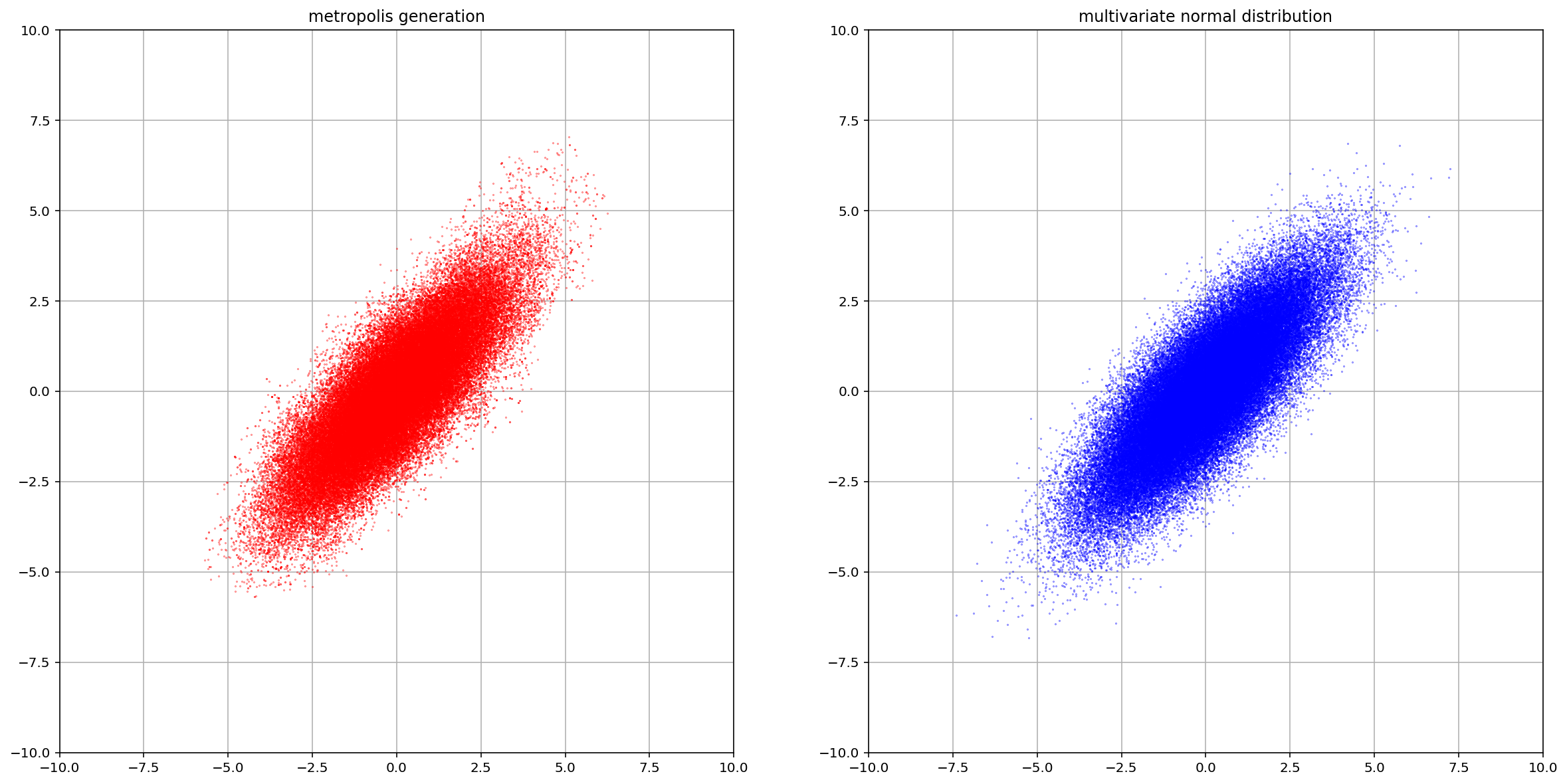連続変数のメトロポリス法
次の2変量正規分布を考える。
\[p(x_1,x_2)=\frac{1}{Z}\exp\left(-\frac{x_1^2-2bx_1x_2+x_2^2}{2}\right)\]$Z$ は正規化の定数。
アルゴリズム
- 任意に初期状態 $(x_1,x_2)$ を一つ選ぶ
- 適当な原点対称の分布$\alpha(x_1,x_2)$ より $\Delta_1,\Delta_2$ を発生させる。
-
候補点 $(x_1^\prime,x_2^\prime)$ を次式で定める。 \(\begin{align*} x_1^\prime \leftarrow x_1+\Delta_1\\ x_2^\prime \leftarrow x_2+\Delta_2 \end{align*}\)
- $r\leftarrow \frac{p(x_1^\prime,x_2^\prime)}{p(x_1,x_2)}$ を計算する。
- 一様乱数 $R\in[0,1]$ を発生させて、 $R<r$ なら候補点を採用し、他のときは元の点にとどまる。
import numpy as np
from numpy.random import *
from matplotlib import pyplot as plt
%matplotlib inline
class gauss_dim_2():
def __init__(self,b,step):
self.b=b
self.step=step
self.x=np.array([0,0])
def gaussian_index(self,x_1,x_2,b):
return -(x_1**2-2*b*x_1*x_2+x_2**2)/2
def relative_rate(self,x_1_prime,x_2_prime):
return np.exp(self.gaussian_index(x_1_prime,x_2_prime,self.b)-self.gaussian_index(self.x[0],self.x[1],self.b))
def gen_val(self):
record=[]
for i in range(self.step+1000):
del_x=rand(2)-0.5
x_prime=self.x+del_x
r=self.relative_rate(x_prime[0],x_prime[1])
switch_prob=rand()
if switch_prob < r:
self.x=x_prime
record.append(self.x)
return record
b=0.8
gauss=gauss_dim_2(b=b,step=100000)
record=gauss.gen_val()
correct=multivariate_normal([0,0],[[1/(1-b**2),b/(1-b**2)],[b/(1-b**2),1/(1-b**2)]],100000)
def gen_x_y_pair(lists):
return [list_[0] for list_ in lists],[list_[1] for list_ in lists]
record_x,record_y=gen_x_y_pair(record)
correct_x,correct_y=gen_x_y_pair(correct)
plt.clf()
plt.figure(figsize=(20,10))
plt.subplot(1,2,1)
plt.plot(record_x,record_y,".",color="red",markersize=0.5)
plt.title("metropolis generation")
plt.xlim((-10,10))
plt.ylim((-10,10))
plt.grid()
plt.subplot(1,2,2)
plt.title("multivariate normal distribution")
plt.plot(correct_x,correct_y,".",color="blue",markersize=0.5)
plt.xlim((-10,10))
plt.ylim((-10,10))
plt.grid()
plt.show()

変数に制約条件が課されているときを考える。 $x_1,x_2$ の間に例えば $x_2\geq 0.5x_1^2+3$ という制約条件が課せられており、この制約条件を満たす範囲内で $\exp\left(-\frac{x_1^2-2bx_1x_2+x_2^2}{2}\right)$ の出現の「重み」で、範囲外では出現の「重み」がゼロであるとする。適当な正規化を施せば( $\exp\left(-\frac{x_1^2-2bx_1x_2+x_2^2}{2}\right)$ の領域内の積分値で割ってやれば)確率分布になるが、 これにメトロポリス法を適用してみる。右の分布だけ見ると正しく生成されているかわからないが、平均値の動きを見ると定常値に収束していることがわかる。 まともに期待値を計算しようと思うと正規化定数 $Z$ を
\[Z=\int_{-\infty}^\infty\int^{\infty}_{0.5x_1^2+3}\exp\left(-\frac{x^2-2bx_1x_2xy+y^2}{2}\right)dydx\]で計算して、
\[\begin{align} &\mathbb{E}[x_1]=\frac{1}{Z}\int_{-\infty}^\infty\int^{\infty}_{0.5x_1^2+3}x_1\exp\left(-\frac{x^2-2bx_1x_2xy+y^2}{2}\right)dx_2dx_1\\ &\mathbb{E}[x_2]=\frac{1}{Z}\int_{-\infty}^\infty\int^{\infty}_{0.5x_1^2+3}x_2\exp\left(-\frac{x^2-2bx_1x_2xy+y^2}{2}\right)dx_2dx_1 \end{align}\]を計算するとかだろうか?母関数とかで直接求めるのもできるかも。
class gauss_dim_2_restrict():
def __init__(self,b,step,restrict_func):
self.b=b
self.step=step
self.x=[0,4]
self.f=restrict_func
def gaussian_index(self,x_1,x_2,b):
return -(x_1**2-2*b*x_1*x_2+x_2**2)/2
def relative_rate(self,x_1_prime,x_2_prime):
return np.exp(self.gaussian_index(x_1_prime,x_2_prime,self.b)-self.gaussian_index(self.x[0],self.x[1],self.b))
def gen_val(self):
record=[]
for i in range(self.step+1000):
del_x=normal(0,0.8,2)
x_prime=self.x+del_x
if self.f(x_prime) == True:
r=self.relative_rate(x_prime[0],x_prime[1])
switch_prob=rand()
if switch_prob < r:
self.x=x_prime
record.append(self.x)
return record[1000:]
def rest_func(x):
f=x[1]-0.5*x[0]*x[0]-3
if f > 0:
return True
else:
return False
gauss_rest=gauss_dim_2_restrict(b=0.2,step=10**5,restrict_func=rest_func)
record_res=gauss_rest.gen_val()
record_res_x,record_res_y=gen_x_y_pair(record_res)
ave_x=[]
ave_y=[]
ave_x_val=0
ave_y_val=0
for i in range(len(record_res_x)):
ave_x_val+=record_res_x[i]
ave_y_val+=record_res_y[i]
ave_x.append(ave_x_val/(i+1))
ave_y.append(ave_y_val/(i+1))
x=np.arange(-10,10,0.1)
y=(x**2)/2+3
plt.figure(figsize=(20,10))
plt.subplot(1,2,1)
plt.title("Under restriction of $x_2\geq x_1^2+3$")
plt.xlim((-10,10))
plt.ylim((0,10))
plt.plot(record_res_x,record_res_y,".",color="red",markersize=0.5)
plt.plot(x,y)
plt.subplot(1,2,2)
plt.title("Metropolis expectancy")
plt.plot(ave_x,ave_y)
plt.plot(ave_x[-1],ave_y[-1],"o",color="orange")
plt.legend(("move of expectancy",r"$(\bar{x}_1,\bar{x}_2)=$(%f,%f)" % (ave_x[-1],ave_y[-1])))
plt.show()
